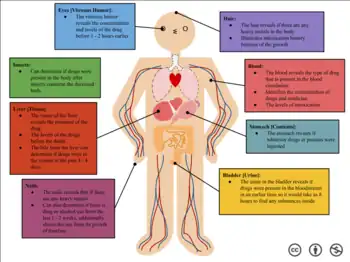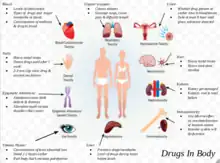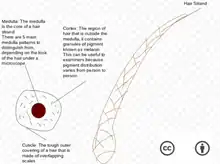Forensic toxicology
| Part of a series on |
| Forensic science |
|---|
 |
|
Forensic toxicology is the use of toxicology and disciplines such as analytical chemistry, pharmacology and clinical chemistry to aid medical or legal investigation of death, poisoning, and drug use. The primary concern for forensic toxicology is not the legal outcome of the toxicological investigation or the technology utilized, but rather the obtainment and interpretation of results. A toxicological analysis can be done to various kinds of samples. A forensic toxicologist must consider the context of an investigation, in particular any physical symptoms recorded, and any evidence collected at a crime scene that may narrow the search, such as pill bottles, powders, trace residue, and any available chemicals. Provided with this information and samples with which to work, the forensic toxicologist must determine which toxic substances are present, in what concentrations, and the probable effect of those chemicals on the person.[1]
In the United States, forensic toxicology can be separated into 3 disciplines: Postmortem toxicology, human performance toxicology, and forensic drug testing (FDT).[2] Postmortem toxicology includes the analysis of biological specimens taken from an autopsy to identify the effect of drugs, alcohol, and poisons. A wide range of biological specimens may be analyzed including blood, urine, gastric contents, oral fluids, hair, tissues, and more. The forensic toxicologist works with pathologists, medical examiners, and coroners to help determine the cause and manner of death. In human performance toxicology, a dose-response relationship between a drug(s) present in the body and the effects on the body are examined. This field of forensic toxicology is responsible for building and implementing laws such as driving under the influence of alcohol or drugs. Lastly, forensic drug testing (FDT) is the detection of drug use among individuals in the workplace, sport doping, drug-related probation, and new job applicant screenings.[1]
Determining the substance ingested is often complicated by the body's natural processes (see ADME), as it is rare for a chemical to remain in its original form once in the body. For example: heroin is almost immediately metabolised into another substance and further to morphine, making detailed investigation into factors such as injection marks and chemical purity necessary to confirm diagnosis. The substance may also have been diluted by its dispersal through the body; while a pill or other regulated dose of a drug may have grams or milligrams of the active constituent, an individual sample under investigation may only contain micrograms or nanograms.

Examples

Urine
A urine sample is urine that has come from the bladder and can be provided or taken post-mortem. Urine is less likely to be infected with viruses such as HIV or Hepatitis B than blood samples.[3] Many drugs have a higher concentration and can remain for much longer in urine than blood. Collection of urine samples can be taken in a noninvasive way which does not require professionals for collection. Urine is used for qualitative analysis as it cannot give any indication of impairment due to the fact that drug presence in urine only indicates prior exposure.[4]
Blood
A blood sample of approximately 10 ml (0.35 imp fl oz; 0.34 US fl oz) is usually sufficient to screen and confirm most common toxic substances. A blood sample provides the toxicologist with a profile of the substance that the subject was influenced by at the time of collection; for this reason, it is the sample of choice for measuring blood alcohol content in drunk driving cases.[5]
Hair sample
Hair is capable of recording medium to long-term or high dosage substance abuse. Chemicals in the bloodstream may be transferred to the growing hair and stored in the follicle, providing a rough timeline of drug intake events. Head hair grows at rate of approximately 1 to 1.5 cm a month, and so cross sections from different sections of the follicle can give estimates as to when a substance was ingested. Testing for drugs in hair is not standard throughout the population. The darker and coarser the hair the more drug that will be found in the hair. If two people consumed the same amount of drugs, the person with the darker and coarser hair will have more drug in their hair than the lighter haired person when tested. This raises issues of possible racial bias in substance tests with hair samples.[6]

Other
Other bodily fluids and organs may provide samples, particularly samples collected during an autopsy. A common autopsy sample is the gastric contents of the deceased, which can be useful for detecting undigested pills or liquids that were ingested prior to death. In highly decomposed bodies, traditional samples may no longer be available. The vitreous humour from the eye may be used, as the fibrous layer of the eyeball and the eye socket of the skull protects the sample from trauma and adulteration. Other common organs used for toxicology are the brain, liver, and spleen.[5]
Detection and classification
Detection of drugs and pharmaceuticals in biological samples is usually done by an initial screening and then a confirmation of the compound(s), which may include a quantitation of the compound(s). The screening and confirmation are usually, but not necessarily, done with different analytical methods. Every analytical method used in forensic toxicology should be carefully tested by performing a validation of the method to ensure correct and indisputable results at all times. The choice of method for testing is highly dependent on what kind of substance one expects to find and the material on which the testing is performed.[7] Customarily, a classification scheme is utilized that places poisons in categories such as: corrosive agents, gases and volatile agents, metallic poisons, nonvolatile organic agents, and miscellaneous.[1]
Gas chromatography-mass spectrometry
Gas chromatography-mass spectrometry (GC-MS) is a widely used analytical technique for the detection of volatile compounds. Ionization techniques most frequently used in forensic toxicology include electron ionization (EI) or chemical ionization (CI), with EI being preferred in forensic analysis due to its detailed mass spectra and its large library of spectra. However, chemical ionization can provide greater sensitivity for certain compounds that have high electron affinity functional groups.[8]
Liquid chromatography-mass spectrometry
Liquid chromatography-mass spectrometry (LC-MS) has the capability to analyze compounds that are polar and less volatile. Derivatization is not required for these analytes as it would be in GC-MS, which simplifies sample preparation. As an alternative to immunoassay screening which generally requires confirmation with another technique, LC-MS offers greater selectivity and sensitivity. This subsequently reduces the possibility of a false negative result that has been recorded in immunoassay drug screening with synthetic cathinones and cannabinoids.[9] A disadvantage of LC-MS on comparison to other analytical techniques such as GC-MS, is the high instrumentation cost. However, recent advances in LC-MS have led to higher resolution and sensitivity which assists in the evaluation of spectra to identify forensic analytes.[10]
Detection of metals
The compounds suspected of containing a metal are traditionally analyzed by the destruction of the organic matrix by chemical or thermal oxidation. This leaves the metal to be identified and quantified in the inorganic residue, and it can be detected using such methods as the Reinsch test, emission spectroscopy or X-ray diffraction. Unfortunately, while this identifies the metals present it removes the original compound, and so hinders efforts to determine what may have been ingested. The toxic effects of various metallic compounds can vary considerably.[5]
See also
References
- 1 2 3 Adatsi, F.K. (2014), "Forensic Toxicology", Encyclopedia of Toxicology, Elsevier, pp. 647–652, doi:10.1016/b978-0-12-386454-3.00387-0, ISBN 978-0-12-386455-0, retrieved 2021-03-04
- ↑ Wagner, Jarrad R. (2020), "Introduction to forensic toxicology", An Introduction to Interdisciplinary Toxicology, Elsevier, pp. 445–459, doi:10.1016/b978-0-12-813602-7.00032-6, ISBN 978-0-12-813602-7, S2CID 213092492, retrieved 2021-03-04
- ↑ Dinis-Oliveira, R; Carvalho, F. F.; Duarte, J. A.; Remião, F. F.; Marques, A. A.; Santos, A. A.; Magalhães, T. T (2010). "Collection of biological samples in forensic toxicology". Toxicology Mechanisms and Methods. 20 (7): 363–414. doi:10.3109/15376516.2010.497976. PMID 20615091. S2CID 20779037.
- ↑ Levine, Barry (1 March 1993). "Forensic Toxicology". Analytical Chemistry. 65 (5): 272A–276A. doi:10.1021/ac00053a003. PMID 8452243.
- 1 2 3 Schiller, Jame (2012). Forensic toxicology and DNA profiling. Vicenta Estrada (1st ed.). Delhi: College Publishing House. ISBN 978-81-323-1309-0. OCLC 789644363.
- ↑ Mieczkowski, Tom (1999). "The Further Mismeasure: The Curious Use of Racial Categorizations in the Interpretation of Hair Analyses" (PDF). Paper Presented at the American Society of Criminology Meetings, November 1999, Toronto, Ontario, Canada. Archived from the original (PDF) on 2007-05-08.
- ↑ Harper, Lane; Powell, Jeff; Pijl, Em M. (December 2017). "An overview of forensic drug testing methods and their suitability for harm reduction point-of-care services". Harm Reduction Journal. 14 (1): 52. doi:10.1186/s12954-017-0179-5. ISSN 1477-7517. PMC 5537996. PMID 28760153.
- ↑ Foltz, Rodger L.; Andrenyak, David M.; Crouch, Dennis J. (2017), "Forensic Science, Applications of Mass Spectrometry", Encyclopedia of Spectroscopy and Spectrometry, Elsevier, pp. 707–711, doi:10.1016/b978-0-12-803224-4.00152-7, ISBN 978-0-12-803224-4, retrieved 2021-03-04
- ↑ Brown, Hilary M.; McDaniel, Trevor J.; Fedick, Patrick W.; Mulligan, Christopher C. (2020). "The current role of mass spectrometry in forensics and future prospects". Analytical Methods. 12 (32): 3974–3997. doi:10.1039/D0AY01113D. ISSN 1759-9660. PMID 32720670. S2CID 220841952.
- ↑ Fanali, Salvatore (2017). Liquid Chromatography : Applications. Paul R. Haddad, Colin Poole, Marja-Liisa Riekkola (2nd ed.). Saint Louis: Elsevier Science. ISBN 978-0-12-809344-3. OCLC 992565369.
External links
- "Forensic Toxicology Information Guide". all-about-forensic-science.com. Retrieved 13 June 2014.